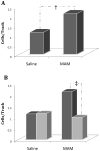Hippocampal dysfunction and disruption of dopamine system regulation in an animal model of schizophrenia
- PMID: 19073417
- PMCID: PMC2879641
- DOI: 10.1007/BF03033801
Hippocampal dysfunction and disruption of dopamine system regulation in an animal model of schizophrenia
Abstract
Studies into the pathophysiology of schizophrenia have consistently demonstrated a dysfunction of dopamine (DA) system regulation in this disorder. This includes hyper-responsivity to DA agonists, the therapeutic efficacy of DA antagonists, and augmented striatal DA release in response to amphetamine. Nonetheless, there is little evidence for a pathological alteration with the DA system itself in schizophrenia. Instead, it is suggested that the disturbance lies in the manner by which the DA system is regulated. Recently, rodent models of schizophrenia have been advanced based on developmental disruption that recapitulates many of the symptoms observed in human schizophrenia patients. We found that administration of the mitotoxin methylazoxymethanol acetate (MAM) to rats at gestational day 17 leads to adult rats that exhibit neuroanatomical, pharmacological, and behavioral characteristics consistent with schizophrenia. These rats also exhibit hyperactivity within the ventral subiculum of the hippocampus that corresponds to a loss of parvalbumin-containing interneurons. This hyperactivity causes an increase in the population activity of the DA neurons (i.e., more DA neurons are firing spontaneously), thus increasing the responsivity of the DA system to stimuli. When the ventral subiculum is inactivated, DA neuron population activity is restored to baseline, and the hyper-responsivity to amphetamine is normalized to that observed in control rats. These findings demonstrate a direct link between the hippocampal pathophysiology, interneuronal alterations, and hyperdopaminergic state observed in the schizophrenia patient. Moreover, this suggests an alternate pharmacotherapeutic approach based on the normalization of hippocampal activity in the treatment of schizophrenia in humans.
Figures


References
-
- Abdul-Monim Z, Neill JC, Reynolds GP. Sub-chronic psychotomimetic phencyclidine induces deficits in reversal learning and alterations in parvalbumin-immunoreactive expression in the rat. Journal of Psychopharmacology. 2007;21(2):198–205. - PubMed
-
- Abi-Dargham A. Do we still believe in the dopamine hypothesis? New data bring new evidence. Internation Journal of Neuropsychopharmacology. 2004;7(Suppl 1):S1–5. - PubMed
-
- Akbarian S, Kim JJ, Potkin SG, Hagman JO, Tafazzoli A, Bunney WE, Jr, et al. Gene expression for glutamic acid decarboxylase is reduced without loss of neurons in prefrontal cortex of schizophrenics. Archives of General Psychiatry. 1995;52(4):258–278. - PubMed
-
- Andreasen NC. Symptoms, signs, and diagnosis of schizophrenia. Lancet. 1995;346(8973):477–481. - PubMed
-
- Benes FM. Is the GABA cell a final common pathway for the etiology and treatment of schizophrenia and bipolar disorder? Current Opinion in Psychiatry. 2002;15(3):277–278.
Publication types
MeSH terms
Substances
Grants and funding
LinkOut - more resources
Full Text Sources
Medical

